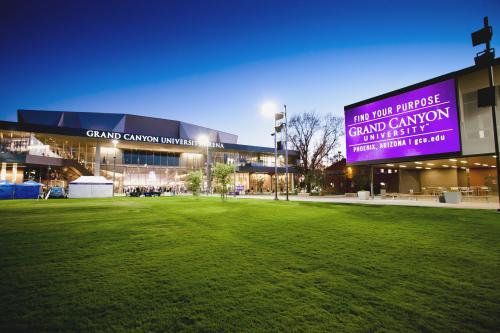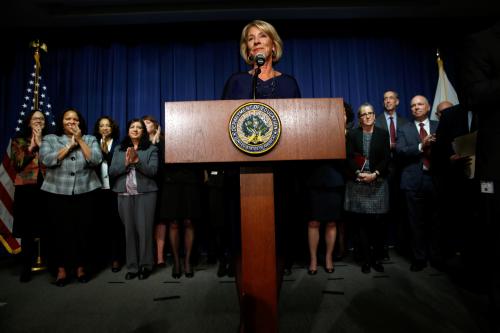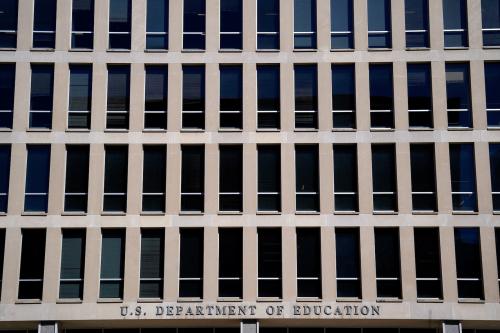The coronavirus pandemic has altered higher education in previously unimaginable ways. Much of the news coverage has focused on debates over campus closures and the decline in enrollment in public and nonprofit institutions. What has not received enough attention is the simultaneous increase in enrollment in for-profit institutions.
A recent report by the National Student Clearinghouse provides some of the first figures documenting college enrollment changes during the pandemic. The patterns are alarming. Undergraduate enrollment in for-profits is up 3% over last year, in stark contrast to a 9% decline in public community college enrollment.
Even more striking are patterns for first-time students. As shown in Figure 1, enrollment in for-profit institutions rose by 13% among first-time students aged 21-24 and rose by 15% among those aged 25-29. Contrast this to public four-year institutions, where enrollment for the same age groups saw declines of over 20%.
The combined effects of a pandemic-induced recession, campus closures, and the deregulation of the for-profit sector under the Trump administration have created a perfect storm for a resurgence of the for-profit sector. In light of extensive evidence that for-profit institutions yield both lower earnings gains and higher debt for students than other institutions, policymakers, students, taxpayers, and voters should be very concerned about this trend.
The For-Profit College Comeback
The rise of online learning combined with lax federal oversight contributed to the rapid growth of the for-profit sector in the early 2000s. The Great Recession further fueled the increase in enrollment; workers seeking retraining were swayed by the convenience of online learning and the (often misleading) marketing of some of the largest for-profit chains. In just the four years between 2006 and 2010, enrollment in for-profit colleges surged by 76%. (This was calculated by the author using data on degree and non-degree enrollment from the Department of Education (2019), Tables 303.25 and 303.20.)
Beginning in 2010, investigations by the Government Accountability Office and the Senate, followed by regulations and sanctions by the Obama administration, led to school closures and enrollment declines in the for-profit sector. In addition to individual actions against specific colleges, the Obama administration put into place restrictions on aggressive recruiting, streamlined the Borrower Defense process for loan forgiveness when colleges defraud students, created the College Scorecard to disseminate information on student outcomes, and established the Gainful Employment rule to hold colleges accountable for the debt and earnings of their graduates. These improved student protections led to a decline in for-profit enrollment and the closure of several large for-profit chains between 2010 and 2016.
When President Trump took office, his own history as a for-profit college owner—Trump University became the subject of multiple lawsuits, which were eventually settled for $25 million—undoubtedly informed the administration’s approach. The Trump administration weakened the Borrower Defense rule, completely rescinded the Gainful Employment regulation, and has done little to enforce restrictions on predatory recruitment practices. Despite adding some data to the College Scorecard, the administration has also reorganized and deleted key pieces of information in ways that seem to favor for-profit institutions. Even before the current recession and pandemic, for-profits were making a comeback.
The pandemic has clearly accelerated the growth of the for-profit sector. Many for-profit institutions were already mostly or entirely online even before the pandemic. Pre-pandemic, 72% of students in four-year for-profits were attending exclusively online, compared to just 12% of students in four-year public colleges. Institutions with more students online before the pandemic were naturally protected from the financial concerns and enrollment declines that come along with a physical campus closure. Online colleges, which are predominantly for-profit, were poised to weather the pandemic in ways that campus-based colleges were not.
Further, higher education is typically countercyclical, meaning that enrollment increases during a recession as unemployed workers seek retraining and students leaving high school or college choose to stay in school to delay entering the labor force. We saw this countercyclicality in the last recession. But, as the National Student Clearinghouse data show, this recession has been markedly different; most campus-based institutions are seeing enrollment declines.
Only the for-profit sector has managed to attract more students. Why? Without having to close campuses, budgets have remained relatively stable, allowing them to continue to out-spend public institutions on advertising. Pre-pandemic, for-profits spent about $400 per student on advertising compared to just $14 by public institutions.
This differential is likely expanding during the pandemic. Reports on college advertising already suggest for-profits’ ad spending is increasing and shifting to pandemic-themed marketing messages to lure students. On top of this, we know that for-profit colleges have been bolstered with about a billion dollars of stimulus funding under the CARES Act, enabling some unscrupulous colleges to continue to take advantage of students during the pandemic.
Cause for Concern
Students pay more and benefit less from for-profit education than from education in other sectors. Over the last two decades, a number of economists have analyzed student outcomes in the for-profit sector–their results are remarkably consistent. The majority of studies on employment and earnings gains find worse outcomes for for-profit students relative to similar students in other sectors.
A 2017 review of the literature found nine studies that considered the earnings of for-profit students and adequately controlled for differences in student demographics across different types of colleges. All nine found negligible earnings gains for for-profit students that remained at or, in many cases, well below the gains of students in the public and nonprofit sectors. Since that review, several additional studies on earnings have found similarly disappointing outcomes for for-profit students. Recent work further documents lower graduation rates among student veterans in the for-profit sector relative to others. In short, the majority of empirical evidence on the topic finds that the outcomes of for-profit students are worse than the outcomes of students in other types of institutions, even after controlling for confounding factors.
On the other side of the balance sheet is the cost of college—and particularly student debt. In for-profit colleges, 74% of first-time, full-time students take out student loans, compared to just 21% at community colleges and 47% in four-year publics. Among those who borrow, for-profit students also take on more debt—about $8,000 per year vs. $4,700 in community colleges and $7,000 in four-year publics.
What drives these differences in debt? Although students in for-profits tend to be from more disadvantaged backgrounds than students in other sectors, research shows that tuition differences are by far the largest driver of differences in debt across sectors—student demographics and resources play a negligible role. Tuition at the average for-profit college is more than four times that of a public community college (about $14,600 vs. $3,500, respectively). Added to this, evidence of aid capture and fraud in student aid have raised concerns about the sector and the enormous debt that for-profit students accrue.
Student borrowing need not be a concern if students are easily able to repay their debt, but this is not the case for many in the for-profit sector. In the 12 years after entering college, nearly 50% of for-profit students defaulted on their student loans, compared to just 13% in community colleges. Default is even more prevalent for students of color and those who leave for-profits before completing degrees or certificates. In fact, more than two-thirds of Black students who attended a for-profit college and left without graduating defaulted on their student loans within 12 years, raising important concerns about racial equity in higher education. Further, economists have documented that the increase in student loan defaults in the early 2000s was associated with an increase in borrowers attending for-profits.
Better Than No College?
Some may argue that a for-profit college education may be better than no college at all, but research calls this into question. Several comparisons of the labor market outcomes of for-profit students to those of individuals with only a high school diploma (no college at all) find no differences in outcomes. Students may even incur net losses from for-profit attendance when debt is factored in.
We also know that students have other college options. Multiple studies show that students can and do shift between the for-profit and public sectors. And when poor-performing for-profit colleges close, students are largely absorbed into other institutions rather than foregoing higher education. The literature is clear: The vast majority of students have other—better—options.
The Future of For-Profits
Data from the last recession and the years since have yielded important lessons about for-profit higher education. In addition to new estimates of the low benefits and very high costs described above, we have also learned about the impacts of various policies affecting the sector. Several studies have examined past or proposed policies that restrict access to federal student aid for poor-performing for-profit colleges. These studies find that such accountability measures work as intended, shift students to higher-quality, lower-cost public institutions, reduce borrowing and defaults, and cause institutions to cut poor-performing programs. In light of the fact that for-profit colleges get roughly 70% of their revenue through federal student aid and are allowed to get up to 90% (not including funding through the GI Bill), additional accountability measures are warranted to protect both students and taxpayers.
In the current climate of regulatory rollbacks, a recession, and a pandemic that’s driving students online, the increase in for-profit enrollment is perhaps not surprising. Add to this the disproportionate share of stimulus funding granted to for-profit colleges in the CARES Act, and it is no wonder that for-profit enrollment is surging, while enrollment other sectors contracts.
We have been down this road before. We have seen a massive expansion in for-profit college enrollment, and we have seen the subsequent harm it caused. The difference this time is that we have the evidence to predict what will happen.
The Brookings Institution is committed to quality, independence, and impact.
We are supported by a diverse array of funders. In line with our values and policies, each Brookings publication represents the sole views of its author(s).







